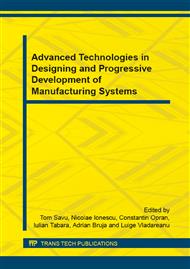[1]
N. Ahmad, A.F.M. Anwarul Haque, Manufacturing feature recognition of parts using DXF files, 4th International Conference on Mechanical Engineering VII (2001), 111-116.
Google Scholar
[2]
M. Pratt, C. Regli, Manufacturing feature recognition from solid models: A status report, IEEE Transactions on Robotics and Automation, vol. 16, no. 6 (2000), 782-796.
DOI: 10.1109/70.897789
Google Scholar
[3]
B. Babic, N. Nesic, Z. Miljkovic, A review of automated feature recognition with rule-based pattern recognition, Elsevier, Science Direct, Computers in Industry 59 (2008), 321–337.
DOI: 10.1016/j.compind.2007.09.001
Google Scholar
[4]
E. Aslan, U. Seker, N. Alpdemir, Data Extraction from CAD Model for rotational parts to be machined at turning centers, Tr. J. of Engineering and Environmental Science, Vol. 23 (1999), 339-347.
Google Scholar
[5]
H.K. Miao, N. Sridharan, J.J. Shah, CAD-CAM integration using machining features, Int'l J. of Computer Integrated Manufacturing 15 (2002), 296–318.
DOI: 10.1080/09511920110077502
Google Scholar
[6]
B. Babic, Development of an intelligent CAD-CAPP interface, in: Proceedings of the Int'l Conference on Intelligent Technologies in Human-Related Sciences, 1996, 351–357.
Google Scholar
[7]
P. Srikanth, C.S. P Rao, G. RangaJanardhan, A novel approach for extraction of design features using DXF files, The Int'l J. of Applied Management and Technology, Vol. 7 (2009), 122-132.
Google Scholar
[8]
V. Sundararajan, P. K. Wright, Volumetric feature recognition for machining components with freeform surfaces, Computer-Aided Design 36 (2004), 11–25.
DOI: 10.1016/s0010-4485(03)00065-4
Google Scholar
[9]
H. Muljadi, K. Ando, H. Takeda, M. Kanamaru, Considering Designer's Intention for the Development of Feature Library of a Process Planning System, The International Federation for Information Processing, Vol. 183 (2005), 381-388.
DOI: 10.1007/0-387-29766-9_32
Google Scholar
[10]
J. Dong, S. Vijayan, Features extraction with the consideration of manufacturing processes, Int'l J. of Production Research 35 (1997), 2135–2155.
Google Scholar
[11]
J.H. Han, I. Han, E. Lee, J. Yi, Manufacturing feature recognition toward integration with process planning, IEEE Transactions Systems, Man and Cybernetics. Part B. Cybernetics 21 (2001), 373–380.
DOI: 10.1109/3477.931522
Google Scholar
[12]
A.D. McCormack, R.N. Ibrahim, Process planning using adjacency-based features, Int'l J. of Advanced Manufacturing Technology 20 (2002), 817–823.
DOI: 10.1007/s001700200222
Google Scholar
[13]
R. Bidarra W.F. Bronsvoort, Semantic feature modeling, Computer-Aided Design 32 (2000), 201–225.
DOI: 10.1016/s0010-4485(99)00090-1
Google Scholar


